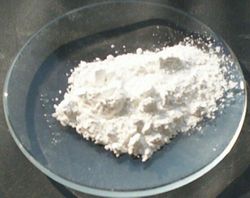Calcium hydroxide

| |
| Names | |
|---|---|
| IUPAC name
Calcium hydroxide
| |
| Other names
Slaked lime
| |
| Properties | |
| Ca(OH)2 | |
| Molar mass | 74.093 g/mol |
| Appearance | White solid |
| Density | 2.211 g/cm3 |
| Melting point | 580 °C (1,076 °F; 853 K) (decomposes) |
| Boiling point | Decomposes |
| 0.189 g/100 ml (0 °C) 0.173 g/100 ml (20 °C) 0.066 g/100 ml (100 °C) | |
| Solubility | Reacts with acids Slightly soluble in glycerol Insoluble in alcohols, alkanes |
| Thermochemistry | |
| Std molar
entropy (S |
83 J·mol−1·K−1 |
| Std enthalpy of
formation (ΔfH |
−987 kJ/mol |
| Hazards | |
| Safety data sheet | Sigma-Aldrich |
| Flash point | Non-flammable |
| Lethal dose or concentration (LD, LC): | |
| LD50 (Median dose)
|
7,340 mg/kg (oral, rat) 7,300 mg/kg (mouse) |
| Related compounds | |
| Related compounds
|
Magnesium hydroxide |
| Except where otherwise noted, data are given for materials in their standard state (at 25 °C [77 °F], 100 kPa). | |
| Infobox references | |
Calcium hydroxide, also known by the names slaked lime and hydrated lime, is an inorganic compound with chemical formula Ca(OH)2. It serves as an intermediate amongst basic calcium compounds, as it can be converted to both calcium oxide or calcium carbonate with relative ease. It is a great starting point for other calcium compounds.
Contents
Properties
Chemical
Calcium hydroxide, which is usually produced by the hydration of calcium oxide, can be re-converted to the oxide by heating it above 512°C for a substantial period of time. Despite its low solubility, calcium hydroxide is a strong base, and produces saturated solutions with a pH of 12.4. This solution, often referred to as limewater, gradually absorbs carbon dioxide from the air, precipitating the less soluble calcium carbonate. Limewater reacts easily with acids to form other calcium compounds, and has an advantage over calcium oxide because these reactions are not intensely exothermic, and an advantage over calcium carbonate in that no carbon dioxide is evolved. It reacts violently with some metals such as aluminium in a manner similar to sodium hydroxide. Calcium hydroxide can be made into sodium hydroxide by combining a saturated solution of it with excess aqueous sodium carbonate, leaving and precipitating the calcium ions out as calcium carbonate, which can be used to make more calcium hydroxide.
Physical
Calcium hydroxide is typically encountered as a fine white powder or as a saturated solution called limewater. When wet or in solution it readily absorbs carbon dioxide, limiting its shelf life.
Availability
Calcium hydroxide is usually referred to outside of the chemistry profession as slaked lime or hydrated lime, and is a very commonly used material in construction, where it is used for cement and concrete. As such, it can be purchased at builders supplies or hardware stores as builder's lime or any of its other names. Calcium hydroxide can also sometimes be bought, but usually in impure form, as a pH increasing agent for lawns and gardens. These products usually contain magnesium carbonate/hydroxide, or calcium sulfate/carbonate as impurities.
Food-grade calcium hydroxide or a mixture of calcium hydroxide and other bases may be found in some Latin American groceries or specialty stores, where it is used in the treatment of corn to produce masa.
Calcium hydroxide sometimes occurs naturally as the mineral Portlandite.
Preparation
Calcium hydroxide is usually prepared by the highly exothermic addition of calcium oxide to water, in a process called slaking. The temperature of this reaction is more than enough to boil water and can produce a caustic spray of limewater that can seriously injure an overenthusiastic chemist, so the addition must be slow and the temperature must be watched.
For those that cannot make calcium oxide, calcium hydroxide can be precipitated by the combination of a solution of sodium hydroxide to one of either calcium chloride or calcium nitrate, taking advantage of the low solubility of calcium hydroxide. When this reaction is done, the resulting precipitate can be very difficult to filter and dry, so dilute solutions should be used. However, calcium hydroxide is soluble enough such that there will be significant losses. It is possible, however, to make calcium oxide by strongly heating calcium hydroxide.
Projects
- Make your own cement
- Chemical scrubbers
- Make alkali metal hydroxides
- Make copper hydroxide
Handling
Safety
Calcium hydroxide is a strong base, and while it's claimed that can cause burns in contact with bare skin, this is more of a problem in dry solid form, and less of a problem when mixed with water (like in the form of slaked lime), as it's poor solubility in water limits its corrosive effects, compared to other alkali bases. If consumed orally it is not very toxic but again is dangerous due simply to the basicity of the compound. Reaction with stomach acid is exothermic, and the heat released may cause injuries if consumed in large amounts. Fine dry calcium hydroxide is very dangerous without a facemask as the dust can cause severe respiratory injury if inhaled and may cause blindness if it contacts the eyes, though these risks aren't quite as high as those of calcium oxide, which reacts much more exothermically. Dry calcium hydroxide is a very strong irritant, and will rapidly dry the skin.
Storage
Since it will absorb carbon dioxide and other corrosive gases from air and react with them, it's best to store it in a sealed container. Make sure it's perfectly dry, as it will tend to solidify inside its container if wet.
Disposal
Calcium hydroxide can be left in air or treated with carbon dioxide to convert it to calcium carbonate, which is harmless and can be disposed of very easily.